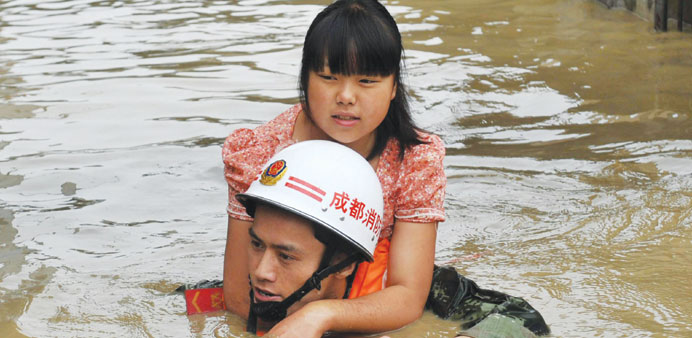|
Heavy rain across China has left at least 28 people dead and 66 missing, officials reported yesterday, after landslides crushed homes, bridges collapsed, and dozens of villages were cut off. |
The storms, which began Sunday, have affected more than 3mn people, the Ministry of Civil Affairs said on its website.
Nearly half of those - 1.45mn people - were in Sichuan, where 62 were missing, the government of the southwestern province said on its Sina Weibo microblog account.
At least 18 people died after a landslide on Wednesday engulfed homes in Zhongxing in the province, the state news agency Xinhua reported yesterday, citing local authorities.
Footage on state broadcaster CCTV showed a wide rush of muddy water, though a reporter said levels had fallen.
Another 12 people were unaccounted for on Wednesday after landslides at a village in Mianyang in the province, the Sichuan government said.
Twelve others and six vehicles were still missing after a bridge in Jiangyou city collapsed into the rushing waters on Tuesday - one of three such incidents in Sichuan.
Other deaths spanned the country, from Beijing to the central province of Henan and Xinjiang in the far west, ministry figures showed.
Some 2,000 people trapped in a tunnel by another landslide in Sichuan were rescued on Wednesday, with television footage showing crowds walking down the middle of a road.
Emergency teams were working to clear a landslide on a road to Beichuan county that had left 40 villages cut off.
Beichuan was the epicentre in 2008 of China’s deadliest earthquake in three decades - an 8.0-magnitude tremor that left more than 87,000 people dead.
Altogether about 110,000 Sichuan residents have been relocated because of the storms, the provincial government said on Weibo, adding that it was still collating the total damage.
Officials in Zhongxing and the provincial capital Chengdu declined to comment when contacted by AFP.
Meanwhile, Taiwan yesterday evacuated more than 2,000 tourists as the island braced for super-typhoon Soulik, while Japan’s Okinawa warned residents that giant waves of up to 12m could pound the archipelago.
Taiwan’s Central Weather Bureau issued a “land warning” at 1230 GMT, a signal issued when a storm is thought to be 18 hours away from Taiwan.
It said the typhoon would remain a threat to Taiwan although latest information shows its strength has declined slightly in the past few hours.
The typhoon, packing gusts of up to 209kph, was 710 kilometres east southeast of the island’s Yilan city in the northeast at 1300 GMT, Taiwan’s Central Weather Bureau said.
A weather forecaster told AFP earlier in the day that the typhoon was approaching the island with gusts of up to 227kph, adding, “that means trees could be uprooted and roofs ripped off”.
Soulik is moving west-northwest towards Taiwan at about 23kph and could narrowly miss the island or make landfall on its northern tip sometime between today evening and tomorrow morning, the bureau said.
“The public must heighten their vigilance as the typhoon will certainly bring strong winds and heavy rains,” the weather forecaster said.
The Taipei-based TVBS news channel said the typhoon was moving along the same route as 1996 super-typhoon Herb, which left 51 dead and 22 missing.
Authorities evacuated 2,300 tourists from Green Island, off the southeastern city of Taitung, and issued a warning to ships sailing north and east of Taiwan to take special precautions.
The Central Emergency Operation Centre also asked the public to stay away from the mountainous areas of central Taiwan, where two recent earthquakes measuring more than 6.0 have struck.
“The soil in the areas has been loosened after the two strong quakes and are prone to landslides,” it said in a statement.
The Okinawa weather bureau in Japan warned waves of up to 12m and gusts of winds up to 234kph may batter parts of the far southwest of the archipelago.
The westernmost inhabited island of Okinawa lies around 100km from the east coast of Taiwan.
The local government said while no specific guidance had yet been issued, people should take the usual precautions.
“It is possible that strong winds will blow things around leading to broken windows and the risk of injury,” an official said.
“The local government may issue instructions and orders as the typhoon closes in,” he added.
The Hong Kong Observatory has classified Soulik as a “super typhoon” on its website because its wind speeds exceed 185 kilometres per hour, while Taiwan’s weather bureau listed it as a “strong typhoon”.
On the Chinese mainland, meteorological authorities maintained an orange alert - the second-highest level - for Soulik yesterday, Xinhua reported.
After hitting or passing Taiwan tomorrow, Soulik is expected to head towards the coastal provinces of Zhejiang and Fujian, bringing “extremely strong” winds, Xinhua cited the National Meteorological Centre as saying.
In August 2009 Typhoon Morakot killed about 600 people in Taiwan, most of them buried in huge landslides in the south, in one of the worst natural disasters to hit the island in recent years.

